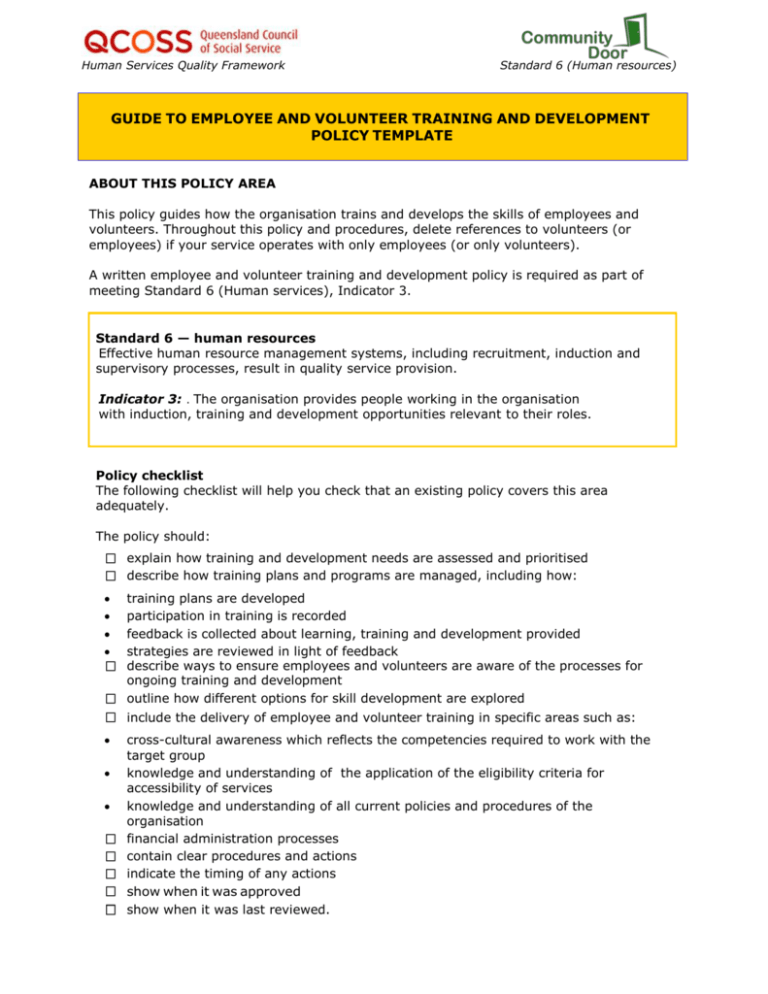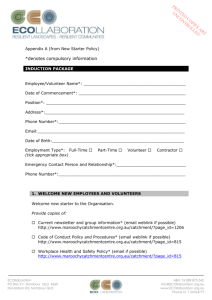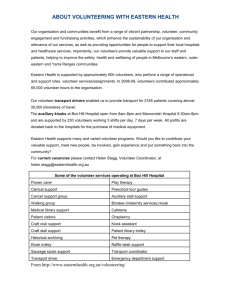Employee and volunteer training and development
advertisement

Human Services Quality Framework Standard 6 (Human resources) GUIDE TO EMPLOYEE AND VOLUNTEER TRAINING AND DEVELOPMENT POLICY TEMPLATE ABOUT THIS POLICY AREA This policy guides how the organisation trains and develops the skills of employees and volunteers. Throughout this policy and procedures, delete references to volunteers (or employees) if your service operates with only employees (or only volunteers). A written employee and volunteer training and development policy is required as part of meeting Standard 6 (Human services), Indicator 3. Standard 6 — human resources Effective human resource management systems, including recruitment, induction and supervisory processes, result in quality service provision. Indicator 3: . The organisation provides people working in the organisation with induction, training and development opportunities relevant to their roles. Policy checklist The following checklist will help you check that an existing policy covers this area adequately. The policy should: explain how training and development needs are assessed and prioritised describe how training plans and programs are managed, including how: training plans are developed participation in training is recorded feedback is collected about learning, training and development provided strategies are reviewed in light of feedback describe ways to ensure employees and volunteers are aware of the processes for ongoing training and development outline how different options for skill development are explored include the delivery of employee and volunteer training in specific areas such as: cross-cultural awareness which reflects the competencies required to work with the target group knowledge and understanding of the application of the eligibility criteria for accessibility of services knowledge and understanding of all current policies and procedures of the organisation financial administration processes contain clear procedures and actions indicate the timing of any actions show when it was approved show when it was last reviewed. Human Services Quality Framework Standard 6 (Human resources) COMPLETING YOUR EMPLOYEE AND VOLUNTEER TRAINING AND DEVELOPMENT POLICY Using the policy template The template provides some example statements. You can adapt these statements and include them in your policy or write your own statements to better suit the operations and services of your organisation. The policy templates include red text prompts to insert information that is specific to your organisation. There are also instruction sections, in blue italics, such as: Refer to the induction of governing body policy template guide for questions and/or examples to consider when customising this section. When you have completed the policy template, delete all the coloured text. For further information on using the policy guides, refer to the information in Using the policy templates and guides. 1. Purpose When identifying the purpose of the policy, consider how it might apply to your employees and volunteers. What are the benefits of well-managed staff and volunteer training and development, for your employees and volunteers, your clients and the organisation as a whole? Do you need to make specific statements to ensure you are inclusive of particular groups, such as Aboriginal and Torres Strait Islander peoples, Australian South Sea Islanders, people from culturally and linguistically diverse backgrounds and people with a disability? 2. Scope To determine the scope of the policy, consider the following questions: • • Does this policy apply to all your organisation’s services and to all volunteers and employees? Are there some standard or universal training and development strategies applied to all employees and/or volunteers? To what extent is the approach you take to training and development a response to each individual’s needs and interests? 3. Policy statement If you are adopting the policy statement in the template, consider whether there are any additional commitments your organisation wants to make. In identifying the actions your organisation will take to implement this policy, you should include the following: • - regularly assessing and prioritising the training needs of each employee and volunteer, taking account of: the qualifications and competencies specific to their role performance reviews identified training needs priorities for the development of the service organisational objectives key trends and issues in the service sector Human Services Quality Framework • • Standard 6 (Human resources) providing training and development opportunities for each employee and volunteer consistent with the training plans developed for each individual and the overall training objectives for the service and organisation assessing feedback from employees and volunteers about the training and development they have undertaken and using this to inform future individual training plans and future training and development strategies for the organisation. 4. Procedures The procedures describe how your organisation achieves the aims and goals you have outlined in your purpose, scope and policy statement. 4.1 Employee training and development Your ongoing employee training and development procedures should explain how you assess, prioritise and meet the training and development needs of your workers. Include consideration of the following: • • • • • • How are training needs assessed and prioritised? How often? Whom by? What format does an individual training plan take? How are opportunities to meet the prioritised needs identified and acted on? How is feedback collected from each employee about training and development undertaken? How is the training plan reviewed and updated? What records do you keep? These should include records of the training needs assessment, a training plan, training undertaken, and the employee’s feedback on the usefulness of the training. 4.2 Volunteer training and development Your ongoing volunteer training and development procedures should explain how you assess, prioritise and meet the training and development needs of your volunteers. Include consideration of the following: • • • • • • How are training needs assessed and prioritised? How often? Whom by? What format does an individual or group training plan take? How are opportunities to meet the prioritised needs identified and acted on? How is feedback collected from each volunteer about training and development provided? How is the individual or group volunteer training plan reviewed and updated? What records do you keep? These should include records of training undertaken and participants’ feedback on the usefulness of the training. 4.3 Training and development strategies Having a training and development plan will assist your organisation implement relevant and timely training and development strategies for all employees and volunteers. The plan should cover the following: • • the organisation’s training and development objectives, and how these relate to service priorities, organisational needs and service sector trends and issues how decisions are made about the content and format of any direct training provided by the organisation, and how and when this process is reviewed and updated Human Services Quality Framework • • Standard 6 (Human resources) how overall training objectives for the organisation are established and used to inform individual and team training plans how feedback from employees and volunteers about the training and development opportunities provided to them are used to review and update the training strategies for the organisation. Consider the needs of employees and volunteers for basic training and updating of skills in specific areas, including: • • • • cross-cultural awareness that reflects the competencies required to work with the target group knowledge and understanding of the application of the eligibility criteria for accessibility of services knowledge and understanding of all current policies and procedures of the organisation financial administration processes, where these are applicable to the person’s role. 5. Other related policies and documents List the other policies related to the employee and volunteer training and development policy. The policy should be linked to: • • • employee and volunteer induction policy employee recruitment policy volunteer selection policy. 6. Review processes Consider how often the policy should be reviewed and the process for doing this: • • • • • • frequency of review: Most policies benefit from an annual review. The experience of implementing the policy is used to decide which changes are necessary. Consider reviewing your employee and volunteer training and development policy as part of an annual review of your organisation’s policies or, if your organisation is small, perhaps over a three-year period. Critical incidents may prompt you to review the policy ahead of schedule. responsibility for the review: In most organisations, the person accountable for human resource management would be responsible for reviewing this policy. In small organisations, this may be the coordinator or manager. In larger organisations, this may be a human resource or personnel manager. process for the review: Decide which particular staff, volunteers, external people and organisations will provide input to the policy review, and whether clients will be involved. decision-making process: Who will review draft changes to the policy and approve changes? What will be the timeframe for the review process? documentation and communication: What records of the policy review process are needed? How will changes to the policy be communicated to staff implementing the policy? In a small organisation, this may be as simple as noting the changes at a staff meeting. In a larger organisation, an email memo may be needed. key questions for the review: Is the policy being implemented? Are procedures being followed? Is the policy clear? What has changed that may prompt a change to the policy (for example, new organisational directions, systems or policies, and significant changes in the broader working environment)? Have particular stakeholders had difficulty with any aspect of the policy? Can their concerns be resolved? How does the policy compare with that of similar organisations?






